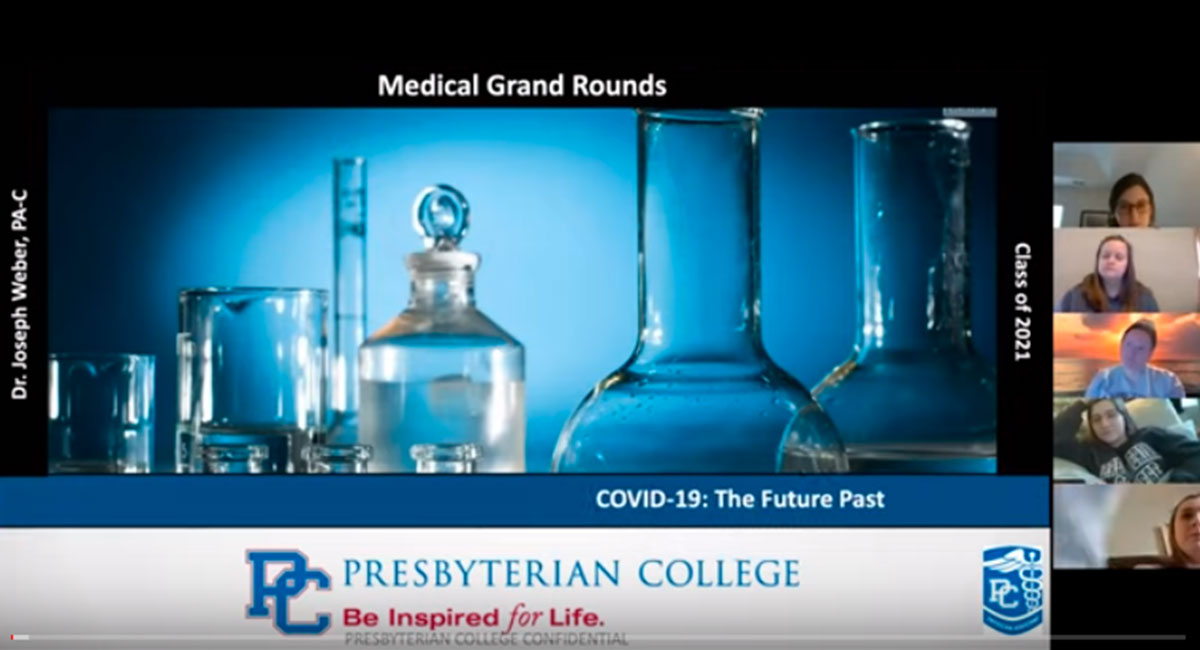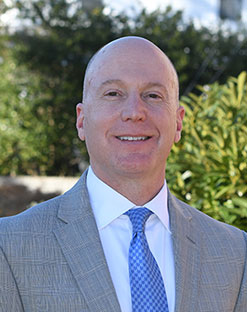PA students study COVID-19 during online presentation
 As the COVID-19 pandemic continues, students and experts in PC graduate health professions, such as the Physician Assistant Studies Program, are studying the disease, the challenges and opportunities the medical community faces.
As the COVID-19 pandemic continues, students and experts in PC graduate health professions, such as the Physician Assistant Studies Program, are studying the disease, the challenges and opportunities the medical community faces.
In the PA Program’s Medical Grand Rounds “COVID-19: The Future Past” presentation this past week, students learned background on COVID-19 and parallels that have happened in history with epidemics and pandemics.
They also discussed the clinical aspects related to the pandemic during the online instruction.
Dr. Joe Weber, Department Chair and Program Director of Presbyterian College’s Physician Assistant Studies, led the virtual presentation on Zoom. The video conferencing app allowed students to continue learning in a virtual classroom-like setting.
“We’re delivering the content live to our students, so we’re using Zoom meetings and delivering it real-time to students,” Weber said. “All of our students are connected in with audio and video. Just as in the classroom setting, students are interacting with the professors and one other.
“We’re broadcasting our lectures in real time. That is an important part of medical pedagogy, to make instruction highly interactive so that students get the best experience, not just from the instructor but from each other.”
Learning about the pandemic
While the news around COVID-19 is evolving rapidly, Presbyterian College PA students examined the most current data.
The presentation included some of the respiratory symptoms associated with COVID-19, such as fever and dry cough.
Coronaviruses can cause the common cold or severe diseases such as SARS (severe acute respiratory syndrome) and COVID-19, according to the Associated Press. The latter of which first appeared late last year in Wuhan, China.
 Regarding COVID-19, Weber said the key symptoms include a fever, which can also show up in a lot of other illnesses like influenza, as well; however, a fever is involved 88% of the time in COVID-19 cases and can range from mild to severe.
Regarding COVID-19, Weber said the key symptoms include a fever, which can also show up in a lot of other illnesses like influenza, as well; however, a fever is involved 88% of the time in COVID-19 cases and can range from mild to severe.
In addition to the fever, is a dry cough, which shows up in about 70% of the cases, according to Weber. The class discussed other symptoms like fatigue or chills that may be less prevalent in some cases, though the data continues to evolve.
“If someone does show up with a fever and dry cough, they’re certainly a candidate for COVID-19 testing, but first would be tested for influenza,” he said. “If the influenza tests are negative, there’s a good reason to go ahead and test for COVID-19.”
A History of pandemics
During instruction, students discussed other pandemics in history and examined the most dangerous epidemics in European and U.S. history.
“Over time, we have mostly developed immunity, medical treatments and vaccines for pathogens causing prior pandemics. COVID-19 is different,” Weber told the students.
“We have none of those options available and are in a unified global race for treatments and vaccines. Medical history is important to learn from and it helps give us guidance to the future.
“If we can come together and solve this crisis, what diseases can we cure next? Can we globally work together to develop cures for multiple sclerosis or Parkinson’s disease, or breast cancer? Possibly. This is a global catalyst to work more closely together and to work with urgency to cure disease.”
He says now is the time for a unified approach.
“This certainly is a time for the team approach and with a unified global approach where we can come together, not just as a unit in a hospital, but as a global community of health care providers to figure out how best to handle the situation,” he continued, “but also really in terms of how to share knowledge between the world health communities on how to treat something as complex as this pathogen.
“I think it’s going to open many doors in the future … where we can really collaborate across borders and boundaries to help each other improve health care for everyone.”
‘Rise to accomplish the heroic’
By now, the public has become familiar with the term social distancing, as well as the phrase “flatten the curve.”
Weber, who has a background in emergency medicine, explained how the slope of the curve in cases from late January has jumped, causing a change in the U.S. administration’s response.
Flattening the curve ensures the healthcare system, which includes an average of 140 million ER visits each year, is not overwhelmed and has a chance to adapt. It also allows time for researchers to come up with treatments and a vaccine.
The community’s part in this is following public health guidelines by social distancing and staying indoors as much as possible. There is a great risk for vulnerable and older people, though Weber shared there have been several news articles lately that have also shown the impact COVID-19 has on young adults.
“They are impacted. It’s not just older people. People, even though they’re younger – even the people who are 20 years old – from 20-49, they’re at a 6-16% higher probability of death than just influenza,” Weber said. “This is frightening.”
This is a great time to think about the PC motto, and remember to think about others, the program director says.
“It’s about caring and serving other people, realizing you need to touch other people’s hearts during these unprecedented times,” Weber said. “Use this time to serve others by calling your neighbors to see if they need anything, donating to charitable causes such as food banks, and showing compassion to those in need.
“This could improve humanity by realizing we are interconnected,” he added. “Rather than complaining about the mundane, we can rise to accomplish the heroic. As we come together as a world to fight a microbial enemy, we can unite as humanity to make our planet a better place for us and for future generations.”
